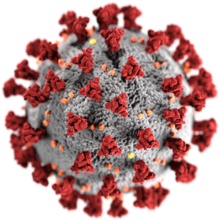Hi, This is Science Feed.

Currently, It has infected over 199 countries and territories around the world and 2 international conveyances: the Diamond Princess cruise ship harbored in Yokohama, Japan, and Holland America's MS Zaandam cruise ship. the day is reset after midnight GMT+0.
Know about COVID-19

How SARS-COV-2 spread in our body?
First, these viruses are taken in our body through nose, mouth or eyes from the droplets of the infected person. Then, viruses travel nasal membrane and mucous membrane in the back of our throat and start infecting cells to multiply rapidly. This causes sore throat and dry cough.

After that, viruses travel through the trachea, bronchi, bronchioles and then alveoli(small air sacs that take in oxygen to capillaries and take out carbon dioxide from capillaries).

When our immune system fights with viruses, our alveolitis gets inflamed and leads to the filling with dead cells, mucus, and germs. Filling of unwanted materials gives our lungs an infection that causes pneumonia in our body and further lung failure and death in severe cases.
Today, We will be talking about COVID-19.
Introduction
COVID-19 is a human to human transmitting infectious disease caused by the SARS-COV-2 virus (a type of coronavirus) which originated from a local seafood market (known as Huanan Seafood Wholesale Market) in the city Wuhan of Hubei province of China.
COVID-19 is a human to human transmitting infectious disease caused by the SARS-COV-2 virus (a type of coronavirus) which originated from a local seafood market (known as Huanan Seafood Wholesale Market) in the city Wuhan of Hubei province of China.
This disease spread from Wuhan to other major cities of China via locals and then to other countries via international tourists.
Currently, It has infected over 199 countries and territories around the world and 2 international conveyances: the Diamond Princess cruise ship harbored in Yokohama, Japan, and Holland America's MS Zaandam cruise ship. the day is reset after midnight GMT+0.
Know about COVID-19
COVID-19 under an electron microscope
Family - Coronaviridae
Sub-family - Orthocoronavirinae
Order - Nidovirales
Genus - Betacoronavirus
Generae of CoVs :
1. Alphacoronavirus
2. Betacoronavirus
3. Deltacoronavirus
4. Gammacoronavirus
Structure:

Crown-like structure of COVID-19
Family - Coronaviridae
Sub-family - Orthocoronavirinae
Order - Nidovirales
Genus - Betacoronavirus
Generae of CoVs :
1. Alphacoronavirus
2. Betacoronavirus
3. Deltacoronavirus
4. Gammacoronavirus
Structure:

Crown-like structure of COVID-19
- positive-stranded RNA viruses
- crown-like appearance (which is due to spike glycoproteins on the outer surface)
- round (or elliptic, or pleomorphic form
- diameter of approx. 60-140 nm
Features :
- sensitive to UV rays and heat
- can be effectively inactivated by lipid solvents including ethers (75%), alcohols, chlorine-containing disinfectants, peroxyacetic acid and chloroform except for the chlorhexidine
Genetic Properties: single-stranded RNA genome contains 29891 nucleotides, encoding for 9860 amino acids
Members of this large family of viruses can cause respiratory, enteric, hepatic, and neurological diseases in different animal species like cattle, camels, cats, and bats.
Common Human CoVs:
HCoV-OC43, HCoV-HKU1, HCoV-NL63, and HCoV-229e are Common Human CoVs where HCoV-OC43 and HCoV-HKU1 are betaCoVs of the A linkage, and HCoV-NL63 and HCoV-229E are alphaCoVs
Other Human CoVs:
SARS-COVs, SARS-CoV-2, and MERS-CoV (betaCoVs of the B and C linkage)
How SARS-COV-2 spread in our body?
First, these viruses are taken in our body through nose, mouth or eyes from the droplets of the infected person. Then, viruses travel nasal membrane and mucous membrane in the back of our throat and start infecting cells to multiply rapidly. This causes sore throat and dry cough.

After that, viruses travel through the trachea, bronchi, bronchioles and then alveoli(small air sacs that take in oxygen to capillaries and take out carbon dioxide from capillaries).

When our immune system fights with viruses, our alveolitis gets inflamed and leads to the filling with dead cells, mucus, and germs. Filling of unwanted materials gives our lungs an infection that causes pneumonia in our body and further lung failure and death in severe cases.
Symptoms
In the initial phases, patients may not show the symptoms.
The most common symptoms are dry cough, fever, tiredness and, in severe cases, breathing problems.

Other symptoms are aches and pains, nasal congestion, runny nose, sore throat or diarrhea.
Prevention
Do these things to protect yourself from COVID-19 :
Treatment for COVID-19
In the initial phases, patients may not show the symptoms.
The most common symptoms are dry cough, fever, tiredness and, in severe cases, breathing problems.
Other symptoms are aches and pains, nasal congestion, runny nose, sore throat or diarrhea.
Prevention
Do these things to protect yourself from COVID-19 :
- Stay home and avoid close contact(3-5 meters) with a sick person
- Cover your nose and mouth with a disposable mask
- Wash your hands regularly for 20 seconds, with soap and water on both sides of your hands, or 60% alcohol-based sanitizer
- Avoid touching your mouth, nose, and eyes unnecessarily
Treatment for COVID-19
There is no specific treatment for this disease. But
Hydroxychloroquine(a derivative of chloroquine) and Azithromycin have been found effective against this virus.
WHO(World Health Organisation) has prescribed to do these things if you show symptoms:
Read More:
NASA has announced to launch mission on Saturn's Natural Satellite - Science Feed
How NASA makes 3d-visualization of an exploded star - Science Feed
Hydroxychloroquine(a derivative of chloroquine) and Azithromycin have been found effective against this virus.
WHO(World Health Organisation) has prescribed to do these things if you show symptoms:
- Rest and sleep
- Keep yourself warm
- Drink plenty of liquids
- Take hot shower
So, that's it for now. Until the next time, this is Science Feed saying goodbye to you all.
Read More:
How NASA makes 3d-visualization of an exploded star - Science Feed
